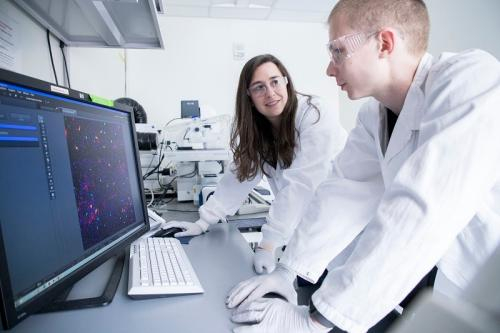The team of researchers from Harvard Medical School (HMS) and Novartis Institutes for BioMedical Research reported the discovery of a new airway cell type online in Nature on August 1. Rapolas Žilionis, PhD student at Vilnius University Life Sciences Center (VU LSC) is the co-first author of the paper "A single-cell atlas of the airway epithelium reveals the CFTR-rich pulmonary ionocyte".
R. Žilionis has just came back to VU LCS after three years of internship at HMS, dr. Allon Klein laboratory. Young scientist says that excitement for the discovery was increasing in every second by scrutinizing scientific literature and figuring out that no one has ever proved the existence of this new airway cell type. "The discovery of pulmonary ionocytes has an important meaning in understanding pulmonary biology and has an impact on an incurable disease - cystic fibrosis," says R. Žilionis. This information can be used in devising new therapeutic approaches to cystic fibrosis.
The researchers used single-cell RNA sequencing to find a new cell type. This technology was invented in dr. A. Klein's laboratory and reported in "Cell" in 2015. Dr. Linas Mažutis, who works at HMS and VU LSC is one of the inventors of single-cell RNA sequencing called InDrops. It allows scientists to capture individual cells in water droplets and wrap those in oil so that the contents of the cells don't mix.
When the team found a new cell type in the data they immediately started to identify the function of new cells. They spotted, among other genes, a gene that causes cystic fibrosis, dubbed CFTR.
"When this gene is mutated it causes cystic fibrosis. It was already known that defects of CFTR correlate with cystic fibrosis, but it wasn't clear in what cells CFTR is active. Dr. Lindsey Plasschaert experimentally finally proved that pulmonary ionocytes which make one or two percent of all airway epithelium are responsible for the activity of CFTR. We called this type "pulmonary ionocyte" because of gene expression similarity to ionocytes found in some other tissues, most commonly in fish and frogs," explains R. Žilionis.
It's the second paper of VU LSC PhD in Nature. R. Žilionis was among co-authors of the article "Osteoblasts remotely supply lung tumors with cancer-promoting SiglecFhigh neutrophils" published in Science last year. Scientific biography of R. Žilionis also includes articles in Nature Protocols, Nature Immunology and others.

